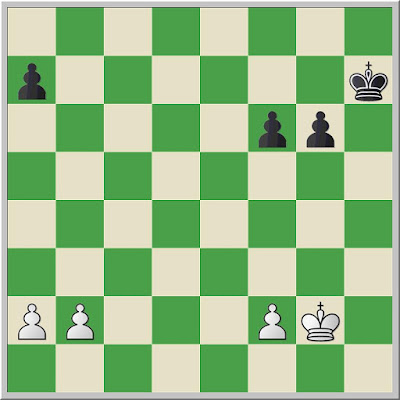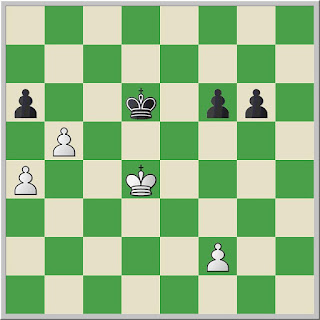In the Inland Empire Open last weekend, I was on board two in the last round, fighting for second place. My opponent and I stood at 3.0 points, while those on board one stood at 3.5 and 4.0. There were other players with 3.0 as well. I faced Pat Herbers, who is at his rating floor of 1900. Several prior games against Pat have been draws, and I have lost a few. I have never beat him.
Stripes,James (1889) -- Herbers,Pat (1900) [D30]
Inland Empire Open Spokane (5), 19.05.2019
1.d4 d5 2.c4 e6 3.Nf3 c5 4.cxd5! exd5 5.Bf4?!
5.g3
5...Nc6 6.e3
6.Nc3 Nf6 7.e3 cxd4 8.Nxd4 Be7 9.Be2 0–0 10.0–0 Be6 11.Rc1 Rc8 12.Qd2 Nxd4 13.exd4 Bb4 14.Bd3 Ne4 15.Qe3 Bxc3 16.bxc3 Nd6 Schleifer,M (2240)--Polacek,J (2250), Toronto 1992 was drawn in 47 moves.
6...Nf6 7.Be2 Bd6 8.Bxd6 Qxd6 9.dxc5 Qxc5 10.0–0 0–0
White to move
11.Nbd2
An instructive game appears in the database.
11.Nc3 Rd8 12.Rc1 Qb4 13.Qc2 d4 14.a3 Qe7 15.Nxd4 Nxd4 16.exd4 Rxd4 17.Nb5 Rd8 18.Nxa7
Black to move
 |
| Analysis Diagram |
18...Bf5
(18...Rxa7 19.Qxc8 Rxc8 20.Rxc8+ Ne8 (20...Qe8 21.Rxe8+ Nxe8) 21.Bb5)
19.Qxf5 Qxe2 20.Qb5 Re8 21.Qxb7 Rab8 22.Qc6 Rxb2 23.Nc8 Re6 24.Qc7 h6 25.Nd6 Kh7 26.h3 Rd2 27.Nf5 Rd7 28.Qb8 Qd3 29.Ng3 Qxa3 30.Rc8 g6 31.Kh2 Qd6 32.Qa8 h5 33.Rd1 Qe7 34.Rxd7 Nxd7 35.Rh8+ Kg7 36.Qg8+ Kf6 37.f4 Rb6 38.Qc8 Kg7 39.Nf5+ gxf5
(39...Kf6 40.Nxe7)
40.Qg8+ 1–0 Morozevich,A (2678)--Grischuk,A (2701), Togliatti 2003.
11...Be6 12.Nb3 Qe7 13.Nbd4 Rac8
White to move
I have a clear plan to play against the isolani.
14.a3 Bg4 15.Qa4 Nxd4 16.Nxd4 Bxe2 17.Nxe2 a6 18.Rfd1 Rfd8 19.Rd3 Rc7 20.Rad1 Rcd7
White to move
21.Qf4
I had a vague sense that I would want my queen on the kingside after Nd4. Perhaps I could have found some other way to probe for weaknesses.
21...Qe4 22.f3
22.Qxe4 dxe4 23.Rxd7 Rxd7
(23...Nxd7 24.Ng3 Kf8 25.Nxe4)
24.Rxd7 Nxd7 25.Ng3 Nf6 should be equal
22...Qxf4 23.Nxf4 Kf8 24.Kf2 Ke7 25.Rd4
25.Ke2 g5 26.Nh3 Rc8 27.R3d2
25.g4!
25...h6 26.R1d3 Rd6 27.Rc3 Rc6
White to move
28.Rxc6?!
Abandoning my plan against the isolani in exchange for temporary control of an open file.
28.Rb4 maintains my opening edge.
28...bxc6
I have converted my opponent's isolani into hanging pawns.
29.Rb4 c5 30.Rb6 Rd6
White to move
My opponent offered a draw here. We both thought my position was slightly better. Conversing with several players in the room while we were waiting for the round's pairings, I pontificated that if any of us were there for money or for chess rating, we were delusional. All of us are relatively weak players compared to professionals, and none of us will earn substantial money for chess. We are there because we enjoy the game.
Naturally, I needed to play on. I paid an entry fee to play chess.
31.Rb8 Rd8 32.Rb3
32.Rxd8 Kxd8 33.Nd3 Nd7 34.b4 Kc7 35.bxc5 a5 36.e4 dxe4 37.fxe4= The computer says equal, but this ending can be very difficult to play.
32...g5 33.Nd3 Nd7
33...c4 34.Rb7+ Rd7 35.Rxd7+ Kxd7 36.Nc5+ Kc6 37.Nxa6 Kb5 38.Nb4=
34.Rb7 c4 35.Ne5 Ke6
White to move
36.Nc6
I considered exchanging into a pawn ending, but could not see clearly that I was better. When I arrived home from the tournament, I entered the game this far into the database and played the pawn ending against Stockfish. I lost.
36...Rc8 37.Nd4+ Kd6 38.Ra7
38.g4 seems unclear
38.Nf5+ Kc6 39.Ra7 Rb8 40.Nd4+ Kd6 41.Rxa6+ Kc7 42.Rc6+ Kd8 43.g4 perhaps White is slightly better.
38...Rb8 39.Rxa6+ Kc7 40.Rxh6
40.Rc6+ gains a critical tempo in the play of kings. 40...Kd8 see at 38.Nf5+. Hastily grabbing the pawn on h6 without first driving back the king let the initiative slip away. It was easy to spot this error after the game.
40...Rxb2+ 41.Kg3 Ne5
White to move
42.Rf6?
42.f4 gxf4+ 43.exf4 Rb3+ 44.Kh4 Ng6+ 45.Kg5 Rd3 with an edge for Black
42.Ra6 seems best.
42...Rd2 43.Rf5
43.Nb5+ Kc8 44.Rf5 Nd7 45.Rxg5 Rd3 46.Rg4 Nb6 47.h4±
43...f6
White to move
44.Nb5+
44.f4 gxf4+ 45.Rxf4=
44...Kc6
44...Kb6 45.a4 Ka5 46.Rxf6 Kxa4 47.Nd4 c3 Black is better.
45.Nc3
45.a4
45...Nd7 46.f4??
Black to move
This move would have been useful a couple of moves back, but now simply gives up a pawn for nothing.
46...Rd3
Pat could have ended my hopes sooner with 46...d4! 47.Nd5 gxf4+ 48.exf4 Rb2 49.Nxf6 Nb6–+ White is ahead two pawns and irredeemably lost.
47.Ne2
47.Na2 Rxe3+ 48.Kg4 Re4 49.Nb4+ Kd6 50.Rxd5+ Ke6 51.Kf3 Rxf4+ 52.Ke3
47...Rxe3+ 48.Kf2 gxf4
White to move
49.Nxf4?
49.Rxf4
49.h4
49...Re5 50.g4
I looked at 50.Rxe5 fxe5 51.Nxd5 Kxd5 and thought that Black should win
50...d4
50...Rxf5 51.gxf5 d4 52.h4= I was optimistic about this line, but the engine says it is equal.
51.Ne2 Re4 52.Rf4
52.h3
52...Rxf4+ 53.Nxf4 Ne5
White to move
54.h3??
54.h4! may salvage the draw 54...Nxg4+ (54...d3 55.Ke3 Nxg4+ 56.Kd2) 55.Ke2.
54...c3–+ 55.Ke2 Kc5 56.g5
Desperation.
56.Ke1 Kc4 57.h4 Nd3+ 58.Nxd3 Kxd3–+
Black to move
56...fxg5 57.Ne6+ Kc4 58.Nxg5 Kb3 59.Ne6 d3+ 60.Ke3 d2 61.Ke2 Kb2 62.Nc5 d1Q+ 63.Kxd1 c2+ 0–1
Herbers finished in second place and won $100. I still have not beat him, although I had some chances. We went over the game quickly together and were the last to leave the playing venue.















































